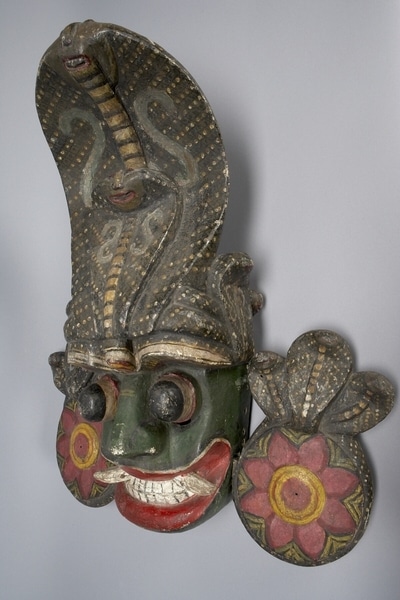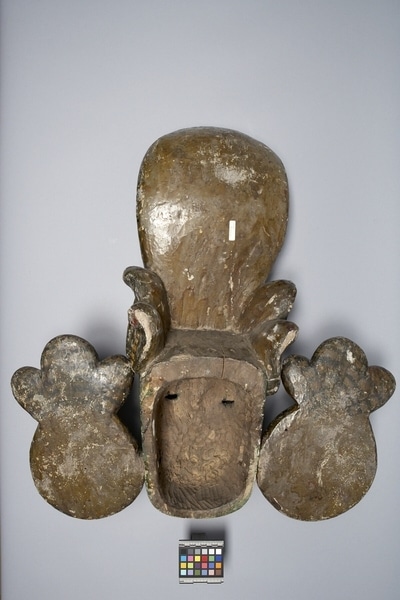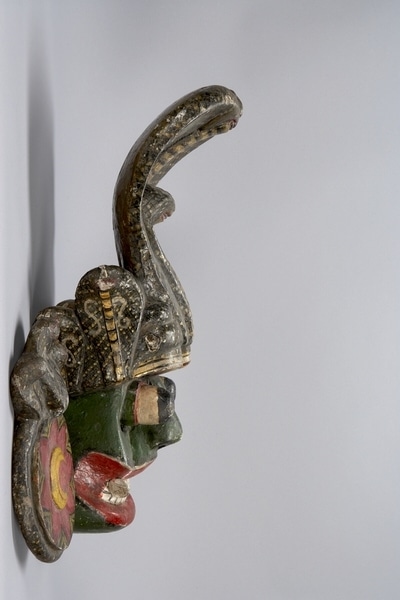Mask Item Number: Eh93 a-c from the MOA: University of British Columbia




Description
Mask with three parts: a) central head piece with cobra-like headdress; b) ear piece that sits on the right side of the head; c) ear piece that fits into the left side of the head. The large, vertically elongated head has a green face, red mouth with white teeth and protruding fangs, a large nose, protruding cylindrical eyes with a crescent-shaped slit below each, and a headdress of two superimposed cobras at the front and one on each side. The cobras are grey-brown with an overall diamond pattern and alternating rows of black and white dots with their eyebrows rendered as thin petal shapes of banded red, white, then black. There are rectangular mortise holes on the sides of the head for the appendage tenons to fit into, and small holes along the edges. Each appendage is circular with an eight-petaled flower, a protruding circle at the centre, and three cobra projections emerging from the top.
History Of Use
The Kolam is a secular entertainment with considerable elements of social satire. It incorporates narrative, mime, dance, and music. A Kolam performance usually has four episodes the precise content of which may vary. These consist of a prelude, detailing the origin of the drama; the arrival of a royal party and dances by characters mythical, human and animal; enactment of a popular story or stories; and a purifying demon dance. Demon masks of this type were worn in the second stage of the ceremony and were used in dances after the "royal party" has entered the performing area.
Iconographic Meaning
This mask is a representation of a serpent demon. These masks typically have fangs, broad open fearsome mouths (this specimen's mouth is closed) and protruding eyes. Cobra kapelles are essential and their number specified by ritual usage. The cobra is important in Sinhalese Buddhism as a mythical protector of Buddha during a storm and as the keeper of his knowledge until man was ready for it. Cobras are associated with water, blood and the lotus plant, which is symbolized on the ear lobes and eyebrows. Multiple cobras symbolize lotus stalks. The lines and dots are typical although usually white and yellow. Kapelles are usually green whereas on this mask grey is dominate. Green faced demons are rare but the red mouth and eye details are typical.
Cultural Context
exorcism
Item History
- Made in Sri Lanka
- Collected during 1978
- Owned by Jason Schoonover before June 10, 1982
- Received from Jason Schoonover (Seller) and Museum of Anthropology Shop Volunteers (Funding source) on June 10, 1982
What
- Name
- Mask
- Identification Number
- Eh93 a-c
- Type of Item
- mask
- Material
- dye ?, paint and nux vomica wood ?
- Manufacturing Technique
- painted, smoked and carved
- Part A
- height 70.0 cm, width 29.5 cm, depth 32.0 cm
- Part B
- height 31.8 cm, width 20.0 cm, depth 5.0 cm
- Part C
- height 32.2 cm, width 21.0 cm, depth 5.0 cm
Who
- Culture
- Sinhalese
- Previous Owner
- Jason Schoonover
- Received from
- Jason Schoonover (Seller) and Museum of Anthropology Shop Volunteers (Funding source)
Where
- Holding Institution
- MOA: University of British Columbia
- Made in
- Sri Lanka
When
- Collection Date
- during 1978
- Ownership Date
- before June 10, 1982
- Acquisition Date
- on June 10, 1982
Other
- Condition
- fair
- Accession Number
- 0812/0009 a-c